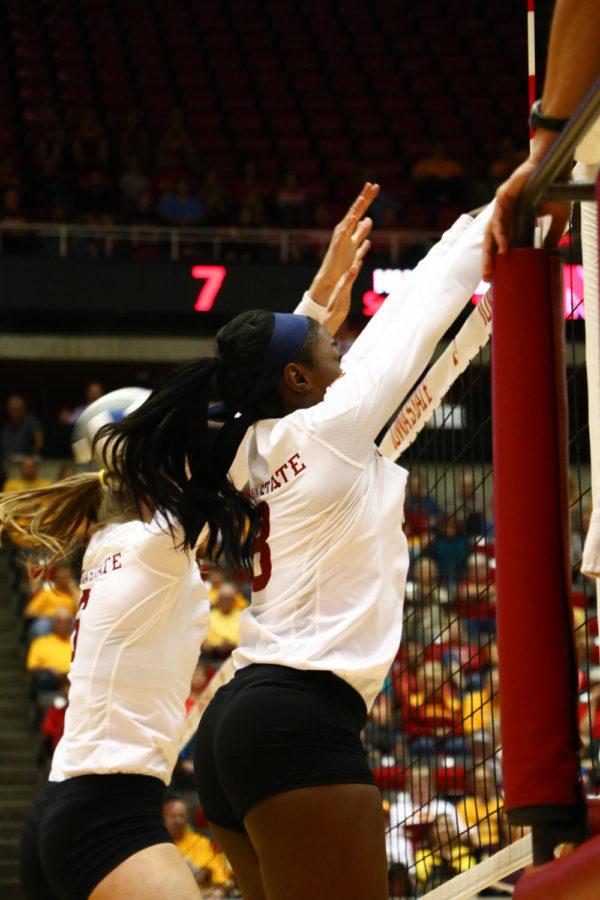Monique Harris finds new role in 5-1 formation
Emily Blobaum/Iowa State Daily
Monique Harris, sophomore, blocks the ball during the game against Nebraska Saturday afternoon. Iowa State lost 3-1.
October 13, 2015
Inside of McCasland Field House in Norman, Okla., the ISU volleyball team was neck-and-neck with the Sooners late in the second set after Oklahoma took the opening game, 30-28.
The Cyclones were clinging to a thin 24-23 lead — attempting to even things up at one set apiece heading into the break.
Redshirt junior Morgan Kuhrt passed the Oklahoma serve to sophomore Monique Harris. Harris sent a backset through the air to sophomore Alexis Conaway, and Conaway attempted the set-winning kill.
Although Oklahoma libero Taylor Migliazzo dug out the attack, the strength of Conaway’s hit was enough to result in an overpass — an overpass that sailed right to the hands of Harris.
“I was thinking, ‘just don’t screw it up,'” Harris said, recalling the play at Oklahoma. “I thought, ‘let me just go up safely with two hands and try to throw it down and hopefully they don’t touch it.'”
Harris’ plan worked to perfection as she sent the ball directly to the floor, eventually leading to a 3-1 match victory for the Cyclones.
ICYMI, @CycloneVB wins 3-1 at OU Match recap from @T_Manks95: http://t.co/09dQcPIVSN We’ll replay it 10/3 at 10p https://t.co/AIxuvT1Hbj
— Cyclones.tv (@CyclonesTV) October 1, 2015
The kill from Harris may have seemed like a typical volleyball play — just a simple kill off an overpass from an ISU attacker. However, prior to Iowa State reverting back to the 5-1 formation on Sept. 11 in Iowa City, Harris was unable to attack from the front row.
During the first six games of the season, the Cyclones operated mainly out of the 6-2 system, using both Harris and junior Suzanne Horner as setters. In the 6-2, the setters only set from the back row, making them ineligible to hit or block from the front.
But after Horner suffered a concussion and the 5-1 returned as the main formation, Harris was then allowed to set from both the front and back rows, making it legal for her to attack and block — a privilege she took advantage of in that second set against the Sooners.
“You look at [Harris], and you think she’s so small,” said ISU volleyball coach Christy Johnson-Lynch. “You think, ‘how could we possibly let her play all-around and in the front row and block?’ But she holds her own.”
Unlike a typical front row player — someone like redshirt sophomore Samara West or freshman Jess Schaben, who measure in at 6 feet 4 inches and 6 feet 2 inches, respectively — Harris stands at just 5 feet 6 inches. For Johnson-Lynch, this height disparity caused some initial concern.
Johnson-Lynch had previously thought the team’s blocking numbers might regress with Harris in the front row, considering how her size matches up to most attackers. The numbers and game film, however, told a different story.
Before the switch to the 6-2, when Harris only played from the back, the Cyclones averaged 6.66 blocks per game. After the switch, the blocking numbers actually improved, increasing to 6.95 per game.
“I’ve looked at a lot of tape with [Harris] blocking, and I think the question is, ‘do we lose a lot of points with her blocking?'” Johnson-Lynch said. “Most matches, [however], we do better when Mo’s [in the] front row than when she’s in the back row.”
Whether its Harris’ ability to compensate for her lack of height with her vertical leap or the utilization of the slide attack with Alexis Conaway, when Harris plays in the front row, the Cyclones have still had success on the court.
Not only has Harris not been an asset in the front row but her new role, which allows her to hit and block from the front row, has improved the production of the team as a whole.
“I think it’s difficult to hit against her,” said redshirt junior Natalie Vondrak. “As a hitter, you don’t really see her block, so you think you’re going to get a kill and bring the ball down, but she’s waiting there. She definitely can hold her own on the block.”







